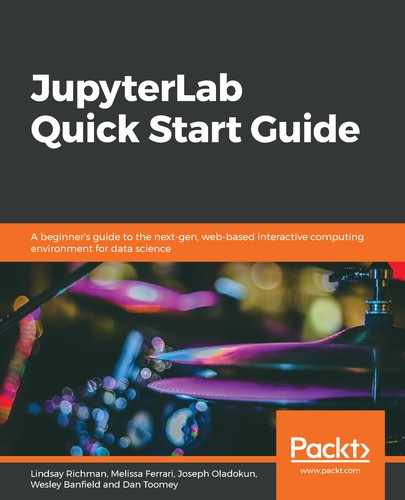To get started, we will install JupyterLab via Anaconda Distribution. Anaconda Distribution is a popular open source tool for individuals who work with data. Its functionality includes package and environment management and it provides an array of popular open source packages that are used for working with data. Anaconda also provides a simple functionality for updating packages and programs, including JupyterLab, which updates and installs necessary dependencies automatically.
Anaconda's distribution functionality supports you when you work with data, not teams.
To install JupyterLab, follow these steps:
- Install Anaconda Distribution by downloading the appropriate Python installer from https://www.anaconda.com/download/, as shown in the following screenshot. A version of Anaconda with Python 2.7 is available for download, but Python 2 will be decommissioned in 2020. For that reason, we recommend using the current version, that is, of Python 3:

Similar installation options are available for Mac, Windows, and Linux.
- Once the file has been downloaded, the installation process will start. Click on the Next button, as follows:

- The licensing agreement will appear on the next screen. Please read it carefully and click on I Agree before moving on to the next step:

- Select the default, Just Me (recommended), unless your computer is used by multiple people. In that case, choose the option for All Users (requires admin privileges):

- The next step is to select the Destination Folder of the software that is being installed and click on Next. A default location will be provided, highlighted in blue, as shown in the following screenshot:

- After clicking on Next, select the Advanced Options, as shown in the following screenshot:

- You have the option to install Microsoft's Visual Studio Code. Visual Studio is a useful, language-agnostic file editor. If you do not already have a preferred file editor, consider installing it. You can click on Skip if you already have a file editor:

- Finally, the installation screen provides optional information about Anaconda Distribution. You can download Anaconda's helpful Starter Guide via the following link: https://docs.anaconda.com/anaconda/user-guide/cheatsheet/. Click on Finish to complete the installation. Use Anaconda Navigator to open Anaconda, find the JupyterLab tile, and hit the Launch button, as shown in the following screenshot:

- You can also open JupyterLab via Command Prompt or the Terminal by entering the following command:
jupyter lab
The preceding command will cause a browser window to open in a new browser tab or window, just like the Launch button does in Anaconda Navigator.
In both cases, your screen should look similar to the following screenshot:

